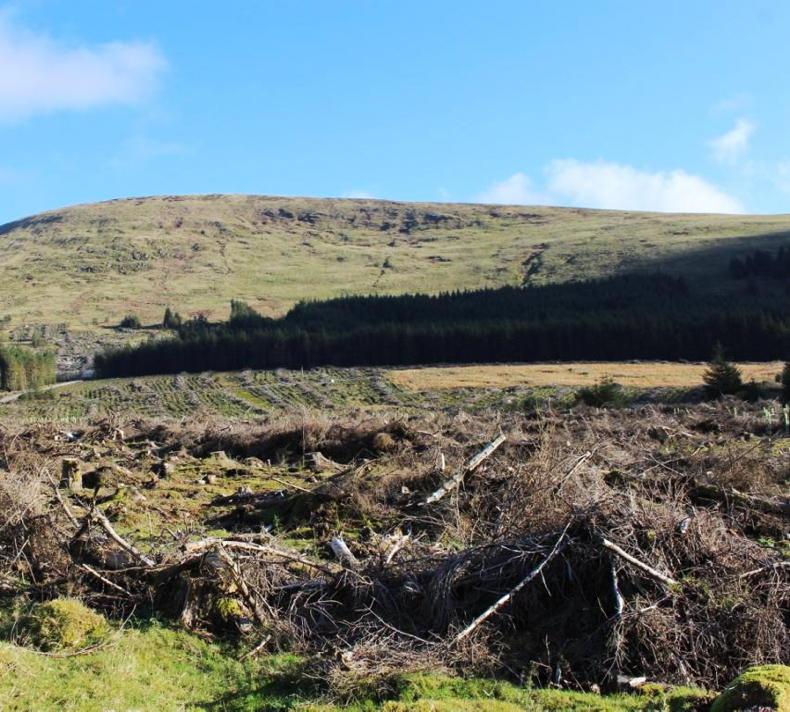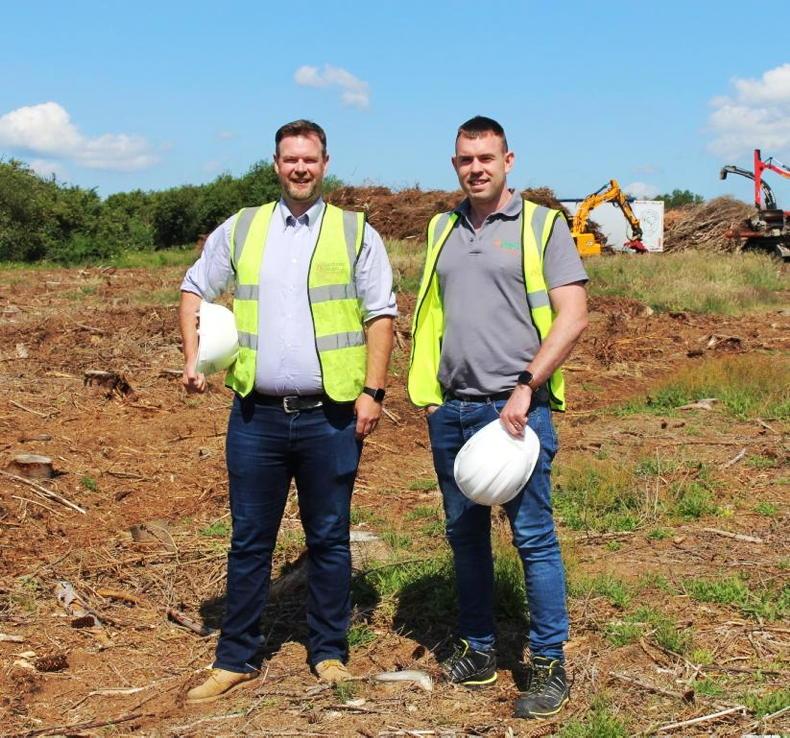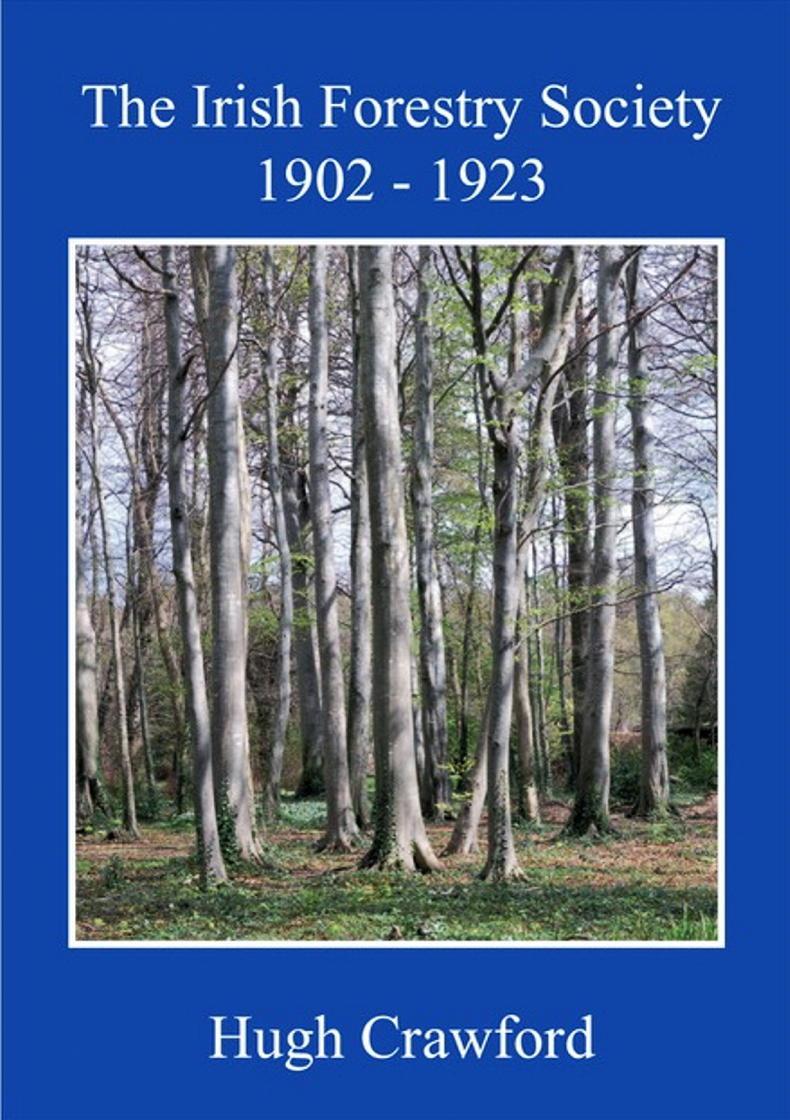Many clearfelled forest sites in Ireland have their branches and treetops mechanically bulldozed into parallel lines or ‘windrows’ to allow mounding and planting in between the rows.
Instead, this lop-and-top or ‘brash’ could be chipped onsite, dried and used for badly needed biomass energy generation, without reducing soil nutrients.
I recently visited two clearfelled areas – one windrowed and one where, instead, most of the brash was removed carefully and chipped for energy generation. The contrast between both sites couldn’t be more stark.
At least a quarter of the windrowed area in Co Wicklow couldn’t be planted as large unsightly rows of brash dominated the site. In some areas, the clearance of brash may have disturbed the top soil, which could result in erosion and nutrient loss.
The site where the brash was removed in Co Kildare was chipped and transported to Bord na Móna’s Edenderry biomass power plant. There was still at least 10% of very light branches and years of cumulative build-up of tree needles and leaves left undisturbed.

Windrowed site – opportunity lost to provide brash for wood energy. \ Donal Magner
Unlike some European countries, stumps and roots were retained on the site, managed by Euroforest Ireland, where I met the company’s foresters John Lawlor and Jordan Foxton.
That the brash contributes to Ireland’s renewable energy programme is important, maintain Lawlor and Foxton, but an added advantage is the reduced cost of reforestation compared with windrowed sites.
“Due to the demand for woodchip as an energy source, it can now be cost-effective to recover brash from harvest sites,” says Foxton.
“However, to be competitive, a number of factors have to be taken into account including the proximity to the power station or processing yard as haulage costs continue to rise.”

John Lawlor and Jordan Foxton, Euroforest Ireland, are advocates of chipping brash on site rather than windrowing. \ Donal Magner
Lawlor maintains that, in most cases, “it is best to wait for a reasonable period for needle and leaf drop to settle before extracting the brash”.
Brash harvesting guide
As Ireland faces a renewable energy crisis, it is incomprehensible that valuable biomass is lost because of costly and needless windrowing, especially at a time when plans are in place to district-heat over 200,000 homes with biomass by 2030.
This is a view shared by the Irish Bioenergy Association (IrBEA), which promotes biomass for energy including brash or specified biomass harvest (SBH) material.
“With the assistance of industry experts and forestry stakeholders, IrBEA has produced a best practice guide for the harvesting of SBH in Irish conditions,” says Noel Gavigan, the association’s executive officer.
The guide offers selection and harvest criteria that will protect the future health of the forest, while also ensuring good quality fuel for the end user.
“It also maximises retention of soil carbon and does not propose harvesting any stumps or roots,” says Gavigan.
As afforestation is in terminal decline, Minister Hackett is well-positioned
to raise the issue at Cabinet
The performance of afforestation since late September to December provides a good indicator of planting performance for the 2023/24 planting season. So far, the signs are ominous.
During October, 15 licences were issued for 196ha of afforestation. The average planting area is 10.7ha per licence, compared with a 7ha average in recent years.
In November, 22 licences were issued, amounting to 217ha of potential planting as the average planted area fell marginally to 9.9ha.
Given that there should be a likely 65% to 75% of licences translating to actual planting, afforestation is likely to be in the region of 1,800ha for the winter-spring planting season.
There is the welcome addition of 83 afforestation licences, previously approved under the 2015-2020 programme, which amounts to 744ha, so even at 65% out-turn, that would add 480ha to the ailing programme.
However, no matter how you juggle the data, Ireland will achieve about a quarter of the minimum 8,000ha expected by the Climate Change Advisory Council (CCAC) and the National Climate Action Plan (NCAP).
It is now important that afforestation performance is raised at Government level, which is possible, as Minister Hackett is the first Minister of State with responsibility for forestry in Ireland who has a voice at Cabinet.
She needs to discuss afforestation performance at this level so that the expectations for forestry, as announced by CCAC and the NCAP, are clearly understood and acted on by Government.
Average funding of €38,000 provided for 42 organisations to promote forestry
The recent announcement by Minister of State Pippa Hackett of €1.6m funding to promote forestry throughout Ireland will be taken up by 42 companies, voluntary groups and forestry organisations.
The funding is the result on an Open Call by her Department earlier this year.
“This call was weighted in favour of projects with a particular focus on engaging with farmers, existing forest owners and other landowners,” said Minister Hackett.
“Over 53 applications were received, of which 42 individual projects have been selected.”
Funding ranges from approximately €4,000 to over €100,000, with the Irish Agroforestry Forum (IAF), Western Forestry Co-op, Irish Timber Growers Association, Hometree, Pro Silva Ireland and Drima Marketing receiving the highest allocations.
IAF continues its ambitious project to promote agroforestry innovation and education nationwide, while Western Forestry Co-op will hold its Woodland Festival ‘Come See the Wood from the Trees’ on Sunday 25 August in Co Leitrim, which has been a huge success in recent years.
Forestry history and information are the subjects of two books which have been recently published by the Irish Timber Growers Association (ITGA) and the Society of Irish Foresters.
The Forestry & Timber Yearbook has been the definitive publication on all aspects of forestry for 35 years.

/ Donal Magner
Published by the ITGA, it contains a directory of virtually every company, organisation and State agency involved in the forestry and forest products sector.
It covers all grants and supports in the Forestry Programme, as well as information on timber prices, woodland taxation, biomass, forest certification and forestry statistics.
Minister Hackett outlines her plans for the sector in the foreword and Brendan Lacey, ITGA chair, provides an overview of forestry, while economist John Fitzgerald discusses forestry and climate change mitigation.
Copies can be ordered online (€14.90 including postage and packaging) at www.forestryyearbook.ie or by contacting ITGA at
01 235 0520 or email info@itga.ie.
The Irish Forestry Society 1902-1923 by Hugh Crawford tells the story of a valiant attempt to restore Ireland’s forests during a turbulent period in Irish history.
Founded in 1902, the Society highlighted the need to restore Irish forests after centuries of exploitation and neglect. Their work has largely been forgotten, perhaps because the Society mainly comprised members of the Protestant Ascendancy.
However, Crawford, a former president of the County Kildare Archaeological Society, acknowledges their contribution in this meticulously researched account of their efforts to advance “scientific and practical forestry in all its branches”, which is an aim that chimes with the mission of The Society of Irish Foresters.

/ Donal Magner
Copies can be purchased for €20 (including post and packaging) from the Society (email info@soif.ie) or contact 086 258 2240.
Many clearfelled forest sites in Ireland have their branches and treetops mechanically bulldozed into parallel lines or ‘windrows’ to allow mounding and planting in between the rows.
Instead, this lop-and-top or ‘brash’ could be chipped onsite, dried and used for badly needed biomass energy generation, without reducing soil nutrients.
I recently visited two clearfelled areas – one windrowed and one where, instead, most of the brash was removed carefully and chipped for energy generation. The contrast between both sites couldn’t be more stark.
At least a quarter of the windrowed area in Co Wicklow couldn’t be planted as large unsightly rows of brash dominated the site. In some areas, the clearance of brash may have disturbed the top soil, which could result in erosion and nutrient loss.
The site where the brash was removed in Co Kildare was chipped and transported to Bord na Móna’s Edenderry biomass power plant. There was still at least 10% of very light branches and years of cumulative build-up of tree needles and leaves left undisturbed.

Windrowed site – opportunity lost to provide brash for wood energy. \ Donal Magner
Unlike some European countries, stumps and roots were retained on the site, managed by Euroforest Ireland, where I met the company’s foresters John Lawlor and Jordan Foxton.
That the brash contributes to Ireland’s renewable energy programme is important, maintain Lawlor and Foxton, but an added advantage is the reduced cost of reforestation compared with windrowed sites.
“Due to the demand for woodchip as an energy source, it can now be cost-effective to recover brash from harvest sites,” says Foxton.
“However, to be competitive, a number of factors have to be taken into account including the proximity to the power station or processing yard as haulage costs continue to rise.”

John Lawlor and Jordan Foxton, Euroforest Ireland, are advocates of chipping brash on site rather than windrowing. \ Donal Magner
Lawlor maintains that, in most cases, “it is best to wait for a reasonable period for needle and leaf drop to settle before extracting the brash”.
Brash harvesting guide
As Ireland faces a renewable energy crisis, it is incomprehensible that valuable biomass is lost because of costly and needless windrowing, especially at a time when plans are in place to district-heat over 200,000 homes with biomass by 2030.
This is a view shared by the Irish Bioenergy Association (IrBEA), which promotes biomass for energy including brash or specified biomass harvest (SBH) material.
“With the assistance of industry experts and forestry stakeholders, IrBEA has produced a best practice guide for the harvesting of SBH in Irish conditions,” says Noel Gavigan, the association’s executive officer.
The guide offers selection and harvest criteria that will protect the future health of the forest, while also ensuring good quality fuel for the end user.
“It also maximises retention of soil carbon and does not propose harvesting any stumps or roots,” says Gavigan.
As afforestation is in terminal decline, Minister Hackett is well-positioned
to raise the issue at Cabinet
The performance of afforestation since late September to December provides a good indicator of planting performance for the 2023/24 planting season. So far, the signs are ominous.
During October, 15 licences were issued for 196ha of afforestation. The average planting area is 10.7ha per licence, compared with a 7ha average in recent years.
In November, 22 licences were issued, amounting to 217ha of potential planting as the average planted area fell marginally to 9.9ha.
Given that there should be a likely 65% to 75% of licences translating to actual planting, afforestation is likely to be in the region of 1,800ha for the winter-spring planting season.
There is the welcome addition of 83 afforestation licences, previously approved under the 2015-2020 programme, which amounts to 744ha, so even at 65% out-turn, that would add 480ha to the ailing programme.
However, no matter how you juggle the data, Ireland will achieve about a quarter of the minimum 8,000ha expected by the Climate Change Advisory Council (CCAC) and the National Climate Action Plan (NCAP).
It is now important that afforestation performance is raised at Government level, which is possible, as Minister Hackett is the first Minister of State with responsibility for forestry in Ireland who has a voice at Cabinet.
She needs to discuss afforestation performance at this level so that the expectations for forestry, as announced by CCAC and the NCAP, are clearly understood and acted on by Government.
Average funding of €38,000 provided for 42 organisations to promote forestry
The recent announcement by Minister of State Pippa Hackett of €1.6m funding to promote forestry throughout Ireland will be taken up by 42 companies, voluntary groups and forestry organisations.
The funding is the result on an Open Call by her Department earlier this year.
“This call was weighted in favour of projects with a particular focus on engaging with farmers, existing forest owners and other landowners,” said Minister Hackett.
“Over 53 applications were received, of which 42 individual projects have been selected.”
Funding ranges from approximately €4,000 to over €100,000, with the Irish Agroforestry Forum (IAF), Western Forestry Co-op, Irish Timber Growers Association, Hometree, Pro Silva Ireland and Drima Marketing receiving the highest allocations.
IAF continues its ambitious project to promote agroforestry innovation and education nationwide, while Western Forestry Co-op will hold its Woodland Festival ‘Come See the Wood from the Trees’ on Sunday 25 August in Co Leitrim, which has been a huge success in recent years.
Forestry history and information are the subjects of two books which have been recently published by the Irish Timber Growers Association (ITGA) and the Society of Irish Foresters.
The Forestry & Timber Yearbook has been the definitive publication on all aspects of forestry for 35 years.

/ Donal Magner
Published by the ITGA, it contains a directory of virtually every company, organisation and State agency involved in the forestry and forest products sector.
It covers all grants and supports in the Forestry Programme, as well as information on timber prices, woodland taxation, biomass, forest certification and forestry statistics.
Minister Hackett outlines her plans for the sector in the foreword and Brendan Lacey, ITGA chair, provides an overview of forestry, while economist John Fitzgerald discusses forestry and climate change mitigation.
Copies can be ordered online (€14.90 including postage and packaging) at www.forestryyearbook.ie or by contacting ITGA at
01 235 0520 or email info@itga.ie.
The Irish Forestry Society 1902-1923 by Hugh Crawford tells the story of a valiant attempt to restore Ireland’s forests during a turbulent period in Irish history.
Founded in 1902, the Society highlighted the need to restore Irish forests after centuries of exploitation and neglect. Their work has largely been forgotten, perhaps because the Society mainly comprised members of the Protestant Ascendancy.
However, Crawford, a former president of the County Kildare Archaeological Society, acknowledges their contribution in this meticulously researched account of their efforts to advance “scientific and practical forestry in all its branches”, which is an aim that chimes with the mission of The Society of Irish Foresters.

/ Donal Magner
Copies can be purchased for €20 (including post and packaging) from the Society (email info@soif.ie) or contact 086 258 2240.










 This is a subscriber-only article
This is a subscriber-only article











SHARING OPTIONS: